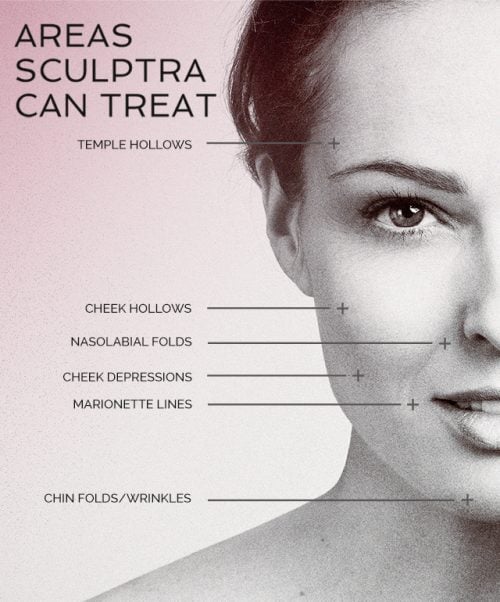There are two reasons someone might consider cheek implants or a cheek filler like Sculptra. One, to reverse the signs of aging. As we age, we naturally lose volume in the face, particularly in the cheeks, which causes a sunken, hollow look. Second, someone might consider cheek implants or fillers because they’re dissatisfied with the aesthetic look of their face. They might feel their face is too thin or they may think they have too much of a “baby face.”
Whatever the reason, there are cheek augmentation options that can help you feel happier about your appearance. Two common options are cheek implants, a surgical treatment, and Sculptra, a long-lasting non-surgical treatment. Each of these treatments has its own pros and cons. To help you decide which is right for you, let’s take an in-depth look at these two options.
Sculptra

First, let’s take a look at Sculptra. Sculptra is a relatively new cosmetic filler that works differently from traditional fillers. Instead of filling the face with injectable plumping agents like hyaluronic acid, Sculptra works the through the injection of the collagen stimulating ingredient poly-L-lactic acid. When strategically injected into the face, this poly-L-lactic acid causes the body to slowly create more collagen in the treatment area.
Collagen is a naturally occurring protein in the body that helps our skin look firm, smooth, full, and youthful. As we age, the collagen in our body diminishes, causing a sagging, wrinkled, or sunken look in the face. So, when Sculptra is injected into the face, it can combat this natural aging, adding back the collagen we have lost. While Sculptra is excellent for treating signs of aging, it can also work well on younger patients who want a fuller look.
Sculptra treatments are done through a series of injection treatments spread out over a few months. The results of the treatment will be gradual, however, once the desired result is reached, Sculptra can last for up to 3 to 5 years. And the results of Sculptra can be maintained with further treatments every 3 to 5 years.
Sculptra Before & After
Pros:
- Non-Invasive
- Non-Surgical
- Gives Natural-Looking Results
- Uses The Body’s Own Collagen
- Treats the Underlying Cause of Aging (Collagen Loss)
- Lasts Longer Than Other Fillers (3 to 5 Years)
- No Recovery Time Necessary
Cons:
- Requires Upkeep (Every 3 to 5 Years)
Best For:
-
- Older Patients Who Show Signs of Aging
- Younger Patients Who Want a Fuller Look
- Patients Who Don’t Want to Undergo Surgery
- Patients Who Don’t Mind Upkeep Treatments

Sculptra Before & After
Cheek Implants
Cheek implants are a surgical treatment designed to change the shape of the face. During this procedure, implants (usually made of silicone) are placed under the skin. This treatment is a good option for those who want to change the shape of their face permanently and are comfortable with getting a surgical treatment.
Cheek implants are not usually the best choice for treating aging. They’re designed to change the shape of the face and not to restore lost fullness.
Pros:
- Permanent
- Great For Changing the Shape of the Face
Cons:
- Expensive
- Surgical
- Painful
- Requires Downtown After Procedure
- Permanent (Must Be Surgically Removed If Patient Is Unhappy With Results)
- Not Best For Treating Loss Of Fullness
Best For:
- Younger Patients Who Want Sculpted Cheekbones
- People Who Want Permanent Facial Structure Change
- Patients Who Are Comfortable With (And Are A Good Candidate For) Surgery
Sculptra vs. Cheek Implants: Which Should You Choose?
When it comes to choosing between Sculptra and cheek implants, the one that’s right for you will depend on your goals and whether you prefer a surgical or non-surgical treatment.
If you’re considering augmenting your cheeks, make an appointment today to talk with Dr. Zadeh about what would be best for your unique aesthetic goals.


